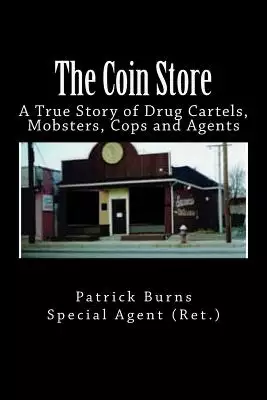U.S. Bank deposit ra的問題,透過圖書和論文來找解法和答案更準確安心。 我們找到下列股價、配息、目標價等股票新聞資訊
U.S. Bank deposit ra的問題,我們搜遍了碩博士論文和台灣出版的書籍,推薦Burns, Patrick寫的 The Coin Store: A True Story of Drug Cartels, Mobsters, Cops and Agents 可以從中找到所需的評價。
國立臺灣海洋大學 海洋生物研究所 黃將修所指導 姍妮的 環境因素對大型甲殼動物 (蝦) 與微型甲殼動物 (橈足類) 生理生態和生物特性之影響研究 (2018),提出U.S. Bank deposit ra關鍵因素是什麼,來自於毒物學、毒物學、潮間灘地、美食奧螻蛄蝦、橈足類、微量金屬。
而第二篇論文國立臺灣大學 海洋研究所 魏志潾所指導 陳孝謙的 臺灣西南海域高屏海底峽谷深海多毛類分類多樣性及功能多樣性之分布 (2018),提出因為有 多毛類、海底峽谷、α多樣性、β多樣性、分類多樣性、功能多樣性、物種置換、物種嵌套的重點而找出了 U.S. Bank deposit ra的解答。
The Coin Store: A True Story of Drug Cartels, Mobsters, Cops and Agents

為了解決U.S. Bank deposit ra 的問題,作者Burns, Patrick 這樣論述:
Pablo Escobar was the King of Cocaine, the wealthiest and most violent criminal in the world. By the 1980s his Medellin Drug Cartel was responsible for smuggling several tons of cocaine into America each and every day, killing thousands of people along the way. The end result was hundreds of mill
ions of dollars in profits, cash profits. In response, and as part of President Reagan's War on Drugs, Congress created the Money Laundering Act of 1986. The goal was to take the profit out of Escobar's business. And the plan was working. Drug Money seizures went up. But as U.S. Agents became more a
nd more efficient at finding the dirty cash, stashed inside ship bellies and truck beds at America's ports and land borders, Pablo and other Cartel leaders sought a more efficient method to get their money back to Colombia. They found the solution in an unlikely place, a dusty back room of a tiny, r
are coin shop in the small town of Cranston, Rhode Island. The shop owner was a young, local mobster who had already been laundering much of the Mob's stolen gold. With a few minor adjustments, his coin shop evolved into a springboard for a new venture, a billion-dollar money laundering scheme. The
Italian Mafia's stolen gold was then used to dispose of the Colombian Cartel's dirty cash. It was the perfect scheme. And as the dirty cash flow increased, the young mobster, known as Fat Man, a.k.a. Mr. Cash, set up a string of phony gold shops crisscrossing America to accommodate it all. The end r
esult was one of the world's largest, most efficient money laundering networks. By some accounts, Fat Man laundered more than a billion dollars of drug profits for Pablo Escobar and the other Cartel leaders. This is the true story of how it all happened. It is a step-by-step view of how the scheme w
orked and how it was ultimately uncovered. This story reveals conventional and at times unconventional tactics used by the government in its three-year, worldwide investigation. It is also a behind-the-scenes look at Fat Man himself and his crew, as well as the agents and cops who pursued them. It w
as unlikely that Fat Man, a small town gangster, would ever become an international money launderer for the Colombian Drug Lords. But what was more unlikely was the fact that it took a rookie agent to finally uncover the scheme. And more unlikely than that was the fact that the rookie agent was Fat
Man's neighbor. Both were born within just a few days from each other. They grew up just a few miles from each other. They lived in similar blue-collar neighborhoods and in all but identical homes. And both were influenced, in very different ways, by the New England Mob, which was headquartered near
by on Federal Hill in Providence, RI. While Fat Man relished a life of crime, I dreamed of becoming an agent. In 1987, while his scheme originally went undetected, I was at the Federal Law Enforcement Training Academy in southern Georgia. One year after the new Money Laundering Law was created, I be
gan work as a new U.S. Treasury Agent. My first post of duty was Providence, RI. My first assignment was to follow a lead, a suspicious cash deposit at a local bank. It was originally considered to be a dead end, "keep busy" work for a new, inexperienced agent with little to do. But that all changed
when I followed the lead to Fat Man's Coin Store. This is how it all happened.
環境因素對大型甲殼動物 (蝦) 與微型甲殼動物 (橈足類) 生理生態和生物特性之影響研究
為了解決U.S. Bank deposit ra 的問題,作者姍妮 這樣論述:
本論文分成兩個主要部分:第一部分研究大型甲殼類─美食奧螻蛄蝦(俗稱鹿港蝦猴,Austinogebia edulis),第二部分研究小型甲殼類─近親真寬水蚤(Eurytemora affinis)這種橈足類動物。本文的目的是(1)探究螻姑蝦在生態工程上所扮演的角色,(2)調查鎘對螻姑蝦的氧化酵素和組織形態上有何影響,(3)評估在螻姑蝦自然棲地中,持久性有機污染物的時間與空間變化,(4)探討複合重金屬對近親真寬水蚤的影響及描述沉積物懸浮物對近親真寬水蚤有何影響,對多世代過程之影響。針對第一點目的,我們著重在描述掘穴管壁和管腔間的顯著差異。螻姑蝦的掘穴管壁具有低滲透性的特色,可增強抗剪強度。從統計
上來看,比較掘穴管壁和背景的沉積物組成,可發現顯著差異。掘穴管壁的有機質含量比單一隻螻姑蝦還要高上24倍,因此,螻姑蝦發揮了生態工程師的角色,將沉積物的特性轉化,其對生態系統造成顯著的生態影響。此外,暴露於鎘中的抗氧化酵素(超氧化歧化酶[SOD]、過氧化氫酶[CAT]、穀胱甘過氧化酶[GPx])活性會隨著鎘濃度增加而減少,也會隨著螻姑蝦器官暴露於鎘的時間增長而減少。暴露於高濃度的鎘中,螻姑蝦的肝胰腺(hepatopancreas)可觀察到顯著傷害,如上皮細胞邊界消失、細胞自基膜脫落、細胞腫脹、壞死等,都是造成傷害的跡象。總結來說,藉由降低抗氧化酵素活性和傷害螻姑蝦主要器官的組織結構,鎘會對螻姑
蝦造成氧化傷害。持久性有機污染物的測量上,空間分布顯示與污染源的距離是最重要的決定性因子。因此,從這些污染物的分布來看,在工業區附近採集到的樣本有較高的濃度。多環芳香烴比例的分析結果顯示,熱裂解和石化相關之汙染來源皆存在。多氯聯苯混合物Aroclor1016和1260是工業區附近的主要來源,近年來雙對氯苯基三氯乙烷(DDT)也成了此區域的污染來源之一。整體來說,文中反映出底棲生物的邊界風險。研究顯示,近親真寬水蚤若暴露於鉛中,雄性的急毒性半數致死濃度(LC50,96小時)是431.99 µg/l,比起雌性的394.27 µg/l有更低的敏感度。在所有暴露處理組別中,總體數量都於第二世代(F1)
達到最低,因此死亡率也在此世代有所增加。在橈足類近親真寬水蚤體內的最高金屬生物累積,同樣在此世代達到更高的數值。由此觀之,繁殖力和存活率似乎與重金屬生物累積有關,匯整結果,可得知近親真寬水蚤的敏感度或適應性與微量金屬累積有直接關聯。在沉積物處理組別中雄性的百分比比例,比重金屬處理組和對照組來得少,多少表明了在多世代的暴露下,橈足類對重金屬和沉積物再懸浮的不同敏感度。
臺灣西南海域高屏海底峽谷深海多毛類分類多樣性及功能多樣性之分布
為了解決U.S. Bank deposit ra 的問題,作者陳孝謙 這樣論述:
生物多樣性是現今環境變遷的一項重要指標,為探討在不同空間尺度下生物多樣性受到強烈環境變化的影響,本研究於2014至2015年底在高屏海底峽谷及其相鄰斜坡重複採集深海底棲多毛類,將生物樣本分類至屬或科,並測量其α-多樣性:包括分類多樣性(Taxonomic diversity)及功能多樣性(Functional diversity),以及β-多樣性:包括群聚組成、物種致換(Turnover)及物種嵌套(Nestedness)的變化,探討不同層面之生物多樣性在強烈內潮擾動之高屏海底峽谷及相對穩定之大陸斜坡的變化。研究結果顯示,由於高屏峽谷強烈內潮的影響,該地區底流速度較快,沉積物侵蝕時間較長,因
此多毛類群聚組成明顯與鄰近斜坡不同。此外由於峽谷強勁底流長時間侵蝕沉積物中較富有機質的細顆粒,因此不論是優勢、常見或是總多毛類分類群及功能群數量都因為食物缺乏及物理擾動而明顯減少。另外,在高屏峽谷及其相鄰斜坡的兩條穿越線中,多毛類β-多樣性主要由物種致換(Turnover)造成,此結果可歸因於由深度梯度造成之環境因子改變,使得適應能力較差之科屬被取代。但若比較峽谷及其相鄰斜坡的採樣,在600公尺以淺,物種嵌套(物種喪失,Nestedness)是影響β-多樣性的主要機制,然而在600公尺以深,物種致換則為影響β-多樣性的主要機制,其原因推測為接近峽谷頭物理擾動較強,造成多毛類區域性滅絕,然而遠離
峽谷頭環境漸趨穩定,較適應擾動環境的多毛類則取代適性較差之科屬。總結來說,透過本研究我們更進一步了解在強烈物理擾動下,深海底棲分類多樣性、功能多樣性及群聚組成的變化及其影響機制。